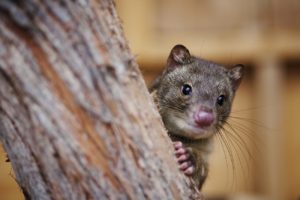Evidence of Endangered Tiger Quolls in the Otways
Listen to the interview on ABC Radio National.
 Holidaymakers in the Otways have unknowingly collected the first evidence of endangered Tiger Quolls in the Otways for almost a decade. The scat has just been confirmed as that of a Tiger Quoll through DNA analysis by Dr Andrew Weeks at cesar, a research centre specialising in genetic analysis for wildlife conservation in Melbourne.
Holidaymakers in the Otways have unknowingly collected the first evidence of endangered Tiger Quolls in the Otways for almost a decade. The scat has just been confirmed as that of a Tiger Quoll through DNA analysis by Dr Andrew Weeks at cesar, a research centre specialising in genetic analysis for wildlife conservation in Melbourne.
Tiger Quolls are the largest marsupial carnivores remaining on the Australian mainland, and, as an apex predator, living at the top of the food chain, the species plays an important role in the ecosystem.
Already endangered, Tiger Quoll populations are declining across their entire range. Although the Otways has traditionally been a stronghold for the species, introduced predators such as foxes and cats have
combined with habitat destruction and fragmentation of populations resulting in dramatic declines over the last several decades and the species is now critically in danger of extinction in this region.
The great news unfolded recently when holidaymakers went to check a heavy thump on their back deck, and found a ‘spotted, ginger’ animal ‘a bit like a big possum’. The animal, which reminded the observers of a Tassie Devil, nonchalantly wandered across the deck, then stopped to drop a scat before jumping off.
Luckily the holidaymakers had the foresight to collect the scat and popped into the local Visitor Information Centre to ask about what they might have seen. The staff there gave them the contact details for the Conservation Ecology Centre (CEC) at Cape Otway.
With the support of their Patron, the Hon. Steve Bracks AC, the CEC is working to conserve Tiger Quolls across the Otways, working with government land management agencies and private landholders.
The Centre’s Co-Founder and CEO, Lizzie Corke, explains why these animals are a top priority for the Centre:
“Healthy and robust ecosystems are vital for the survival of us all and every species lost further jeopardises the ability of these ecosystems to bounce back. Because of their large home ranges and their position at the top of the food chain, efforts made to conserve the Tiger Quoll benefit a wide range of other species which depend on the habitats of the Otways. So much has been lost already that we need to make an urgent and concerted effort to care for what we have left.”
Acting Senior Biodiversity Officer at The Department of Sustainability and Environment, Saul Vermeeren, discusses the Otways quoll population:
“We don’t know how many quolls we still have living in the wilds of the Otways, or if they still constitute a genetically viable population. The confirmation that Quolls still exist in the region gives us the power to make informed planning
decisions on the management of public land. Hopefully by undertaking more intensive surveys and considering appropriate land management practices we will be able to generate positive outcomes for the species that will allow it to flourish in the wild.”
To understand more about the Tiger Quoll, DSE, Parks Victoria and the Conservation Ecology Centre are surveying for them using established techniques such as remote sensor cameras. The CEC is also developing a team of detection dogs, trained to search out Tiger Quoll scats. Tiger Quoll scats are then confirmed through DNA analyses.
“Scats contain DNA from the source animal, and we can therefore determine the species which left the scat using species specific DNA markers” Dr Andrew Weeks explains.
A key threat to Tiger Quolls is invasive predators, particularly foxes, and efforts to decrease fox numbers are vital for ensuring the future of Tiger Quolls in the Otways.
If you have seen a Tiger Quoll or are interested in getting involved with the program as a volunteer contact us.
The Conservation Ecology Centre is embarking on an important project to control foxes and feral cats as part of our Tiger Quoll Flagship Project.
Foxes and cats are very adaptable and extremely proficient at making themselves at home in the Australian environment. Foxes and cats compete with endangered Tiger Quolls for prey and foxes may also kill young quolls. These introduced predators also have a devastating impact on many other Australian wildlife species including small mammals and birds, so our efforts to control them under our Flagship program will assist with the conservation of many other native species.
How we’re able to undertake the project
The feral predator control project is supported by a State Government Caring for our Country Community Action Grant and will concentrate on private land bordering the Great Otway National Park. The work will complement existing fox and cat control programs carried out by Parks Victoria and DSE. Engaging around 30 landholders and individual properties will lead to a coordinated approach which is vital for effective feral predator management and will significantly contribute to landscape conservation.